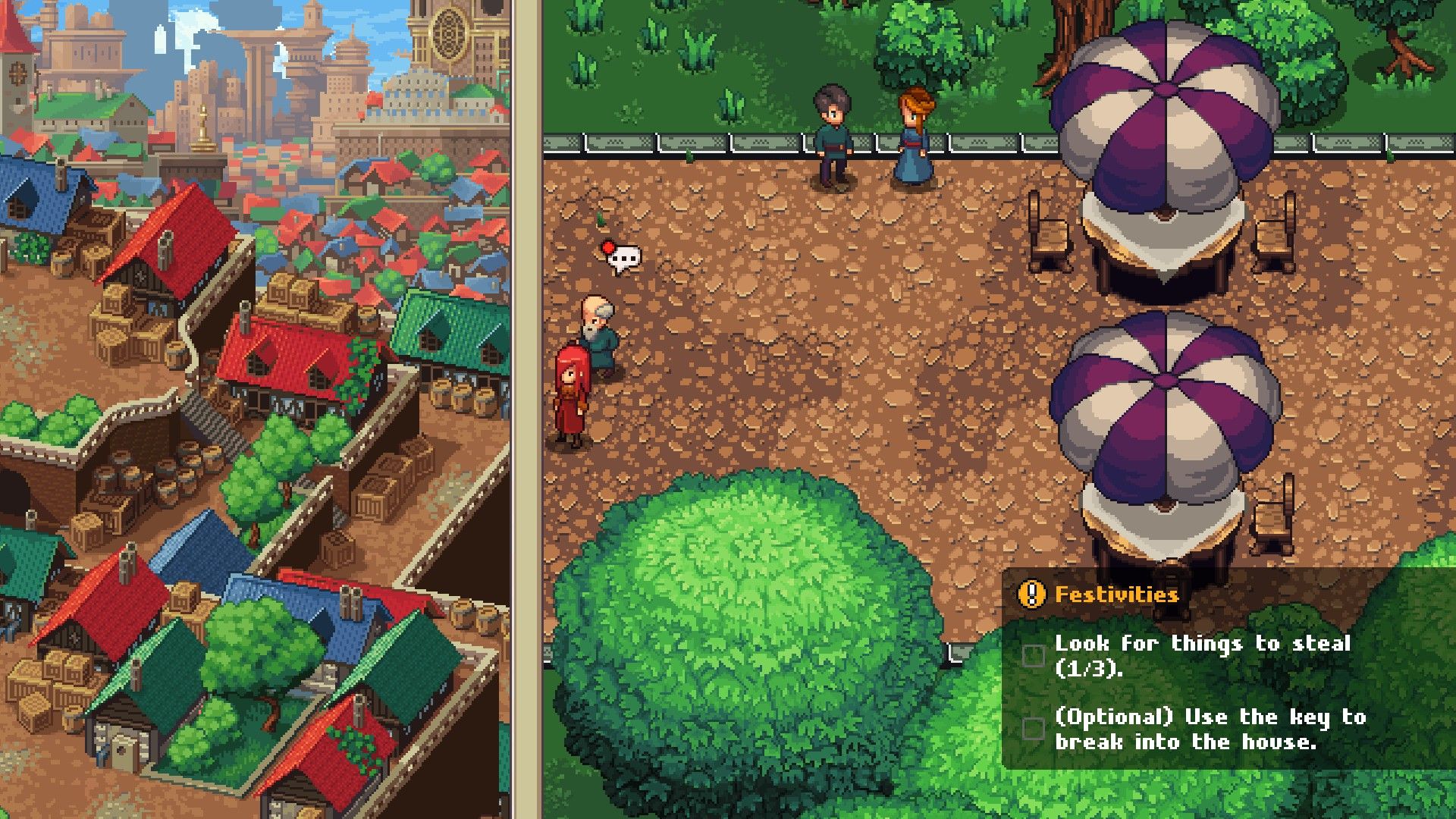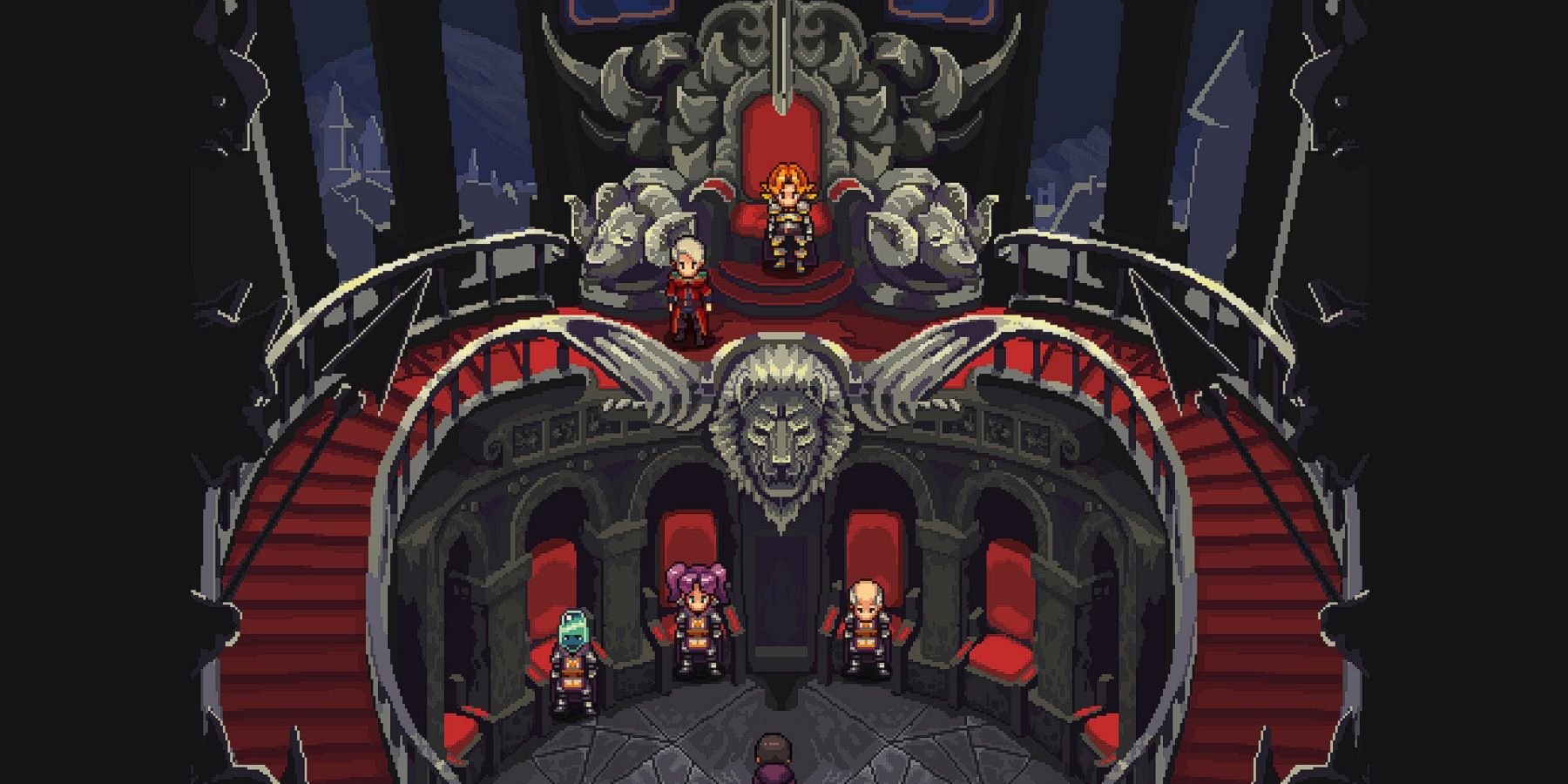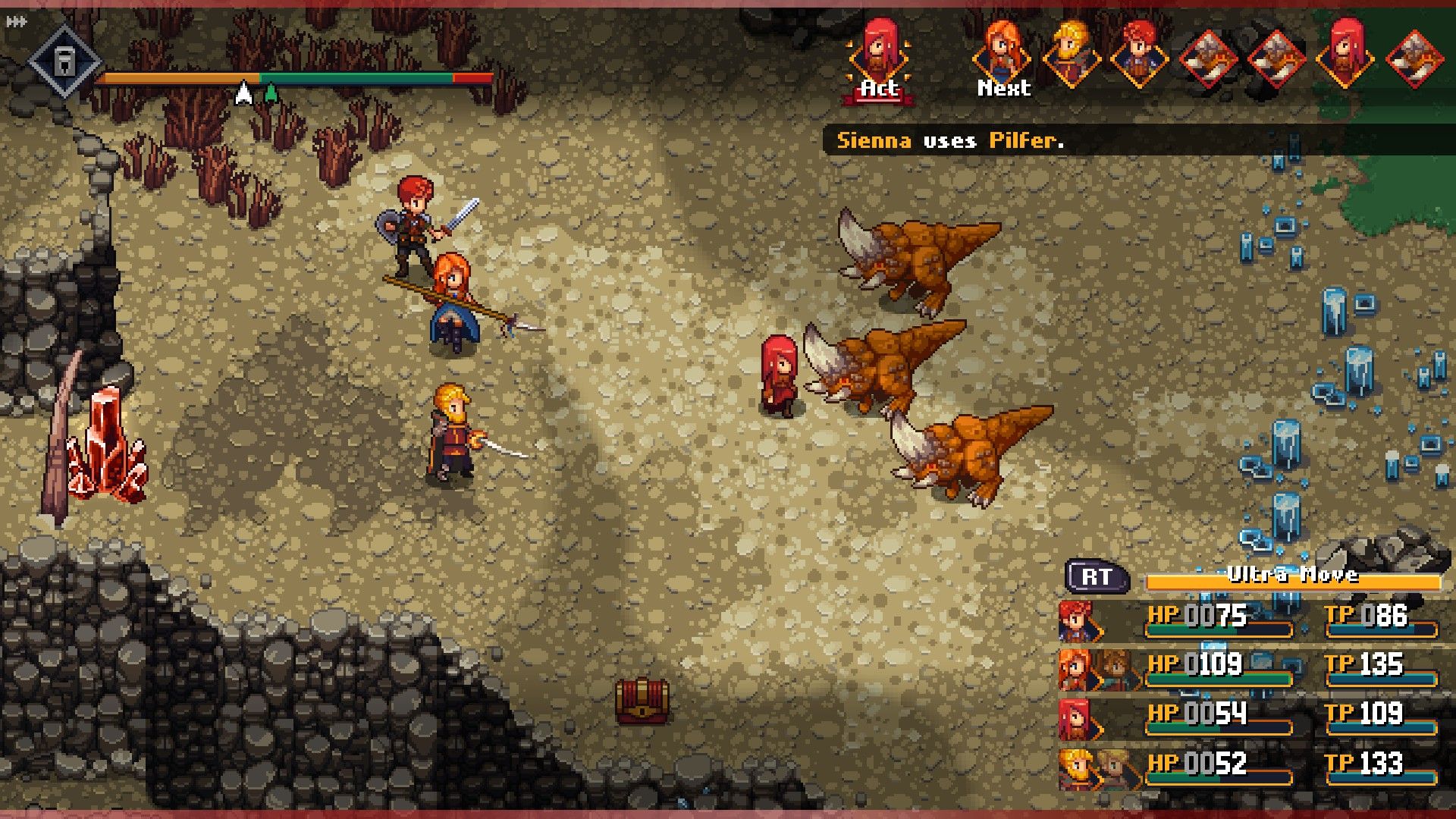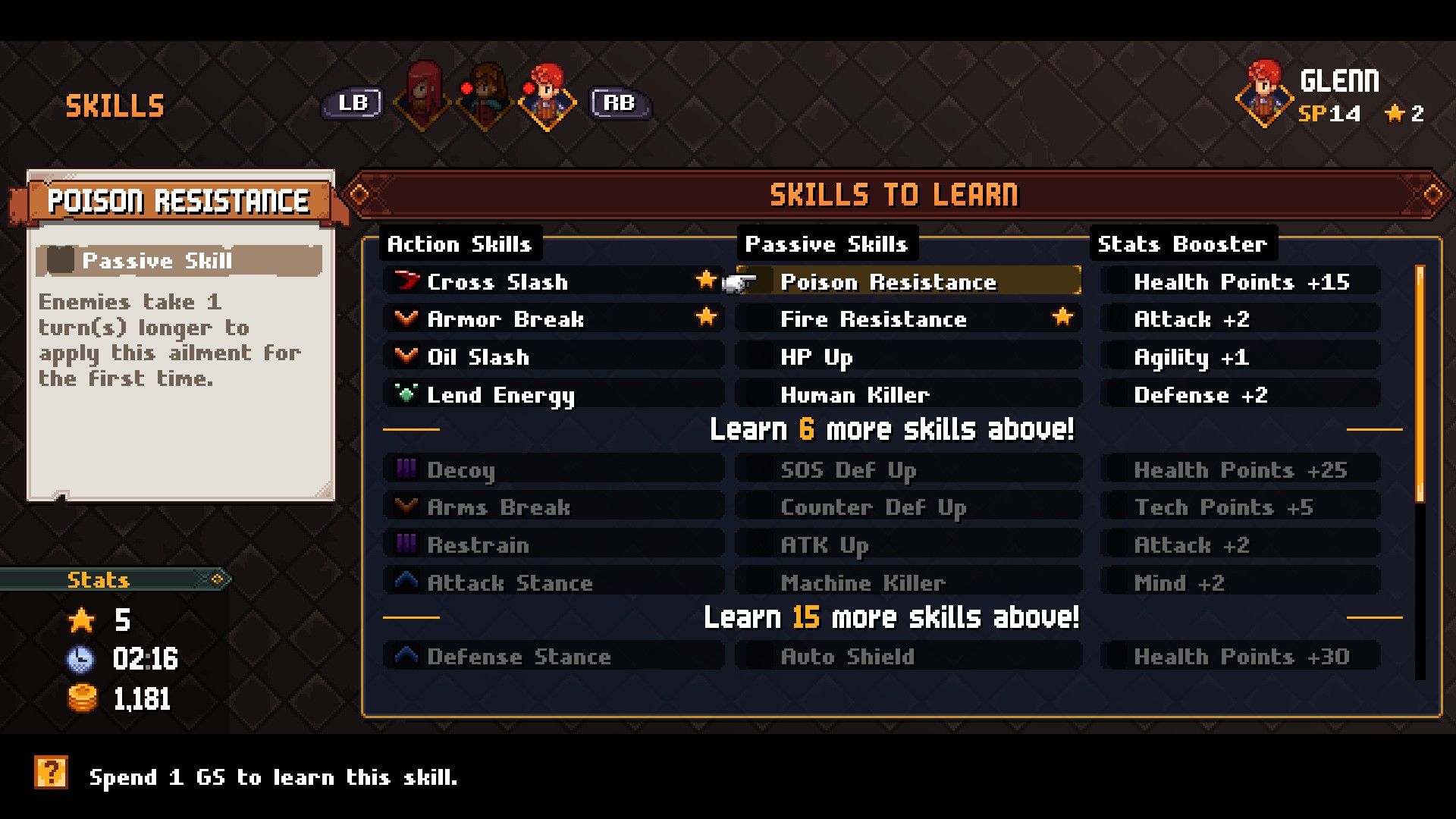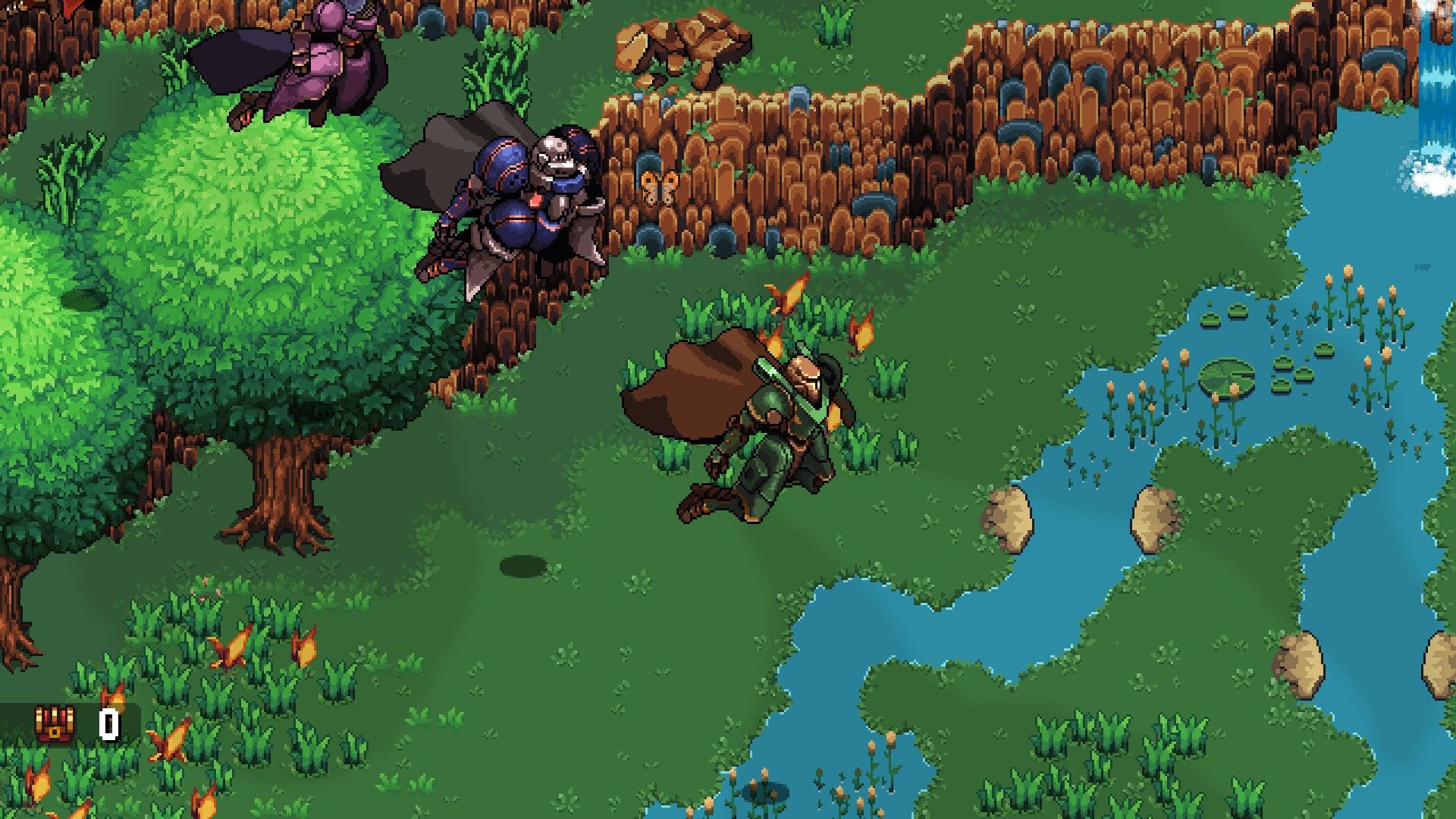Attempting to harness the nostalgia of past generations to craft a gaming experience that feels familiar yet new is a monumental task. Many developers have tried in recent years but few so rarely stack up. Though much of Matthias Linda's early development came from cutting his teeth on unfinished RPG Maker homages, roughly 4,600 people put their faith in the developer. His project raised €163,222 (about $174,219 as of this writing) for the promise of a pixelated JRPG that captures everything people love from the best the SNES and PlayStation era of the genre has to offer. Since the fundraising campaign for Chained Echoes wrapped up in May 2019, Linda and his assembled team have been toiling away to deliver on that promise, and now gamers finally see the fruits of that labor pay off.
After opening moments that are a clear homage to Square Enix's Chrono Trigger, players are drawn into a conflict on the continent of Valandis in the world of Eldrea. It is a land that has known little else but war among its three ruling nations for over a century, and one of the game's focal heroes, Glenn, is pitched into the center of the conflict. Unwittingly, the young man triggers a cataclysmic event that forever changes the course of the war and leaves him equally scarred from the countless lives he feels responsible for taking. Pressing further into the tale introduces other vital players in the game's events by controlling or bumping into them. Eventually, these heroes come together, filling out a broad roster and providing insights from all walks of life for players to explore. On the surface, Linda has created a seemingly straightforward tale that slots perfectly into the usual JRPG romps of the weak battling the strong and gods toying with the fates of mere mortals.
However, Chained Echoes delves deeper, touching on very human elements - foibles and all - that could only result when gods-given magic, eternal beings, and story threads spanning lifetimes are mixed with political intrigue. And while hosting an extensive cast runs the risk of portraying paper-thin protagonists; thankfully, each gets its due course to explore their humanity, only lightly treading on the odd genre trope. They offer relatable struggles and joys on some level, be they an anthropomorphic goat or a red-haired, free-spirited thief, contributing a lot of heart to the story's core. All of this takes place against an incredibly fascinating backdrop of outstanding world-building that players will delight in exploring. Despite the odd slip here and there in localization, Chained Echoes offers a compelling tale with expertly balanced pacing that draws players in with each chapter and, for the better, never quite lands as one might predict.
Beyond a story of substance, the game is designed with a lot of moving parts, but great care is evident in the well-crafted gameplay systems. As with any JRPG, combat is a vehicle for character progression, but Chained Echoes handles the turn-based mechanic with its own spin. In the beginning, it's the familiar lineup of PCs on one side and foes on the other, exchanging blows and whittling down HP. However, the Overdrive system offers an exciting push and pull to turn-based combat as each action moves the party towards a red danger zone or pulls them back into the green sweet spot, where skills cost less to use, characters take less damage, and deal more in turn.
The types of attacks used, and a few other actions govern movement along the Overdrive bar, necessitating a certain amount of attention and thought in battle. While each skill uses TP that basic attacks can restore when needed, players are highly encouraged to use their diverse abilities with wanton abandon, as the party restores after each encounter. There is also an Ultra Ability bar that charges throughout and using the bar allows one character to unleash an ultimate skill, like a devastating attack or a miracle cure. While some are more useful than others, they can favorably nudge a battle, and add a lot of flair. Finally, the initial party makeup is small, and the skills are few, but as it grows, characters can start pairing up and are able to swap in and out as needed during engagements. All of these factors make for an incredibly engaging, strategic system with plenty to do each turn.
As the chapters progress, players are drip-fed further mechanics instead of dumping it all at the front of the game. Combat takes a significant shift in the open field areas through the introduction of Sky Armors. After being teased with them early in the game, players are finally able to control a party of mecha that fly about the map. These machines offer a new take on the Overdrive system for those encounters, too, so combat doesn't feel like the same experience except with robots. Sky Armors introduce a completely new strategy to adapt, which can be punishing if taken lightly. With the new exploration method, players will want to revisit past locations to find each nook and cranny they could not reach before, either due to overwhelmingly powerful monsters they can now face or because of their newfound flight ability. Either way, giant fighting robots are a delight and don't feel like a tacked-on piece of fan service.
With such a tactics-heavy battle system, character progression must offer flexibility and diversity to keep players engaged. Too many RPGs offer exciting combat but have their party peak too early, leading to rote engagements barring the odd boss encounter. To avoid this pitfall, Chained Echoes eschews the classic experience system. While characters earn skill points (SP) through each encounter, which serve to level up the skills they have equipped, the party can only grow through spending Grimoire points. These are earned after pivotal battles and as rewards for completing chains on the Reward Board, affording each character a broad selection of active and passive skills and stat boosts. While the selection seems limited at first, eventually the choices are nearly overwhelming, making it easy to tailor each character to suit particular strategies.
While the system doesn't allow for changes in skills or benched heroes during combat, should the party fall in battle, the game offers a chance to retry after a quick stop in the menu to make any necessary adjustments. Because each skill affects the Overdrive bar when used, character skills have an associated tactic, be it magic, healing, attack, status effecting, etc. If too many characters are heavy in one type of strategy, they hit the red and get pounded on far too often. And while there are items that can circumvent this, the party offers so much flexibility that overusing items of any kind is unlikely, except in the direst of circumstances. It's a well-thought-out system of progression that pairs beautifully with the fast-paced, engaging combat and ensures players will be excited to pop into the menu upon earning a new Grimoire point.
Creating further thrills while romping about Valandis, Chained Echoes has a fairly robust Reward Board working in the background. It works as advertised, providing significant rewards for hitting specific milestones, like completing sidequests, killing a particular type of enemy, finding secrets, and even completing encounters in a specific way. Coupled with the Adventurer's Guild that offers hunts for unique monsters and the hidden Class Emblems and ultimate weapons that further enhance party members when equipped, there is plenty of excitement when entering a newly discovered area of Valandis. It also means there is plenty for endgame exploration to pursue if left unfound on the first go.
Should tight gameplay, an intriguing world, and solid storytelling, all steeped in nostalgic references, not be enough to draw players in, Chained Echoes boasts beautifully executed polish in its style. From where it started on Kickstarter to the final release, the game's pixelated world has been a developing work of art. The spritework and assets are stunning, with fluid animations bringing friend and foe alike alive.
Each city and location has distinctive styles that make them unique and thrilling to run about, feeling alive with bustling NPCs and endemic life. While their layouts can be a bit clunky to navigate in places, they're a feast for the eyes, so it's a minimal chore to trek through them. This same level of graphical care extends to the game's UI, making menus easy to navigate and understand (though it would be welcome to have access to the tutorials again.) Minor gripes aside, the game looks terrific, with some clear references and roots in familiar fantasy. But it also showcases some truly bizarre and outlandish design choices that remind players Chained Echoes has a fantastical world that is all its own.
Supporting the gorgeous visuals is a soundtrack by relative newcomer Eddie Marianukroh. Riding the fine line between capturing nostalgic references and presenting his own clear voice, Marianukroh's work is an absolute delight to listen to while adventuring. There are nods to other standout works, like Xenoblade Chronicles, Final Fantasy VI, and more recently, Octopath Traveller, and some Chained Echoes tracks would not be out of place paired against such giants.
Considering the hubris of Chained Echoes, it should not work, but it does, and beautifully. Matthias Linda has created a broad world that is ripe for further exploration. The only worry now is that the bar is set too high, but it's hard to imagine the team creating anything with less passion and polish. After playing through a creative, familiar, yet distinct game that engages players in nearly every way, one can only hope that there will be more from the brilliant team behind Chained Echoes.
Chained Echoes is available now for PC, macOS, Microsoft Xbox One, Nintendo Switch, Sony PlayStation 4, and macOS. Game Rant was provided a PC code for the review.

